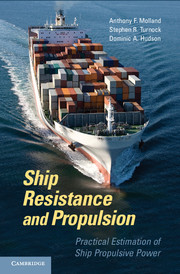Book contents
- Frontmatter
- Contents
- Preface
- Nomenclature
- Abbreviations
- Figure Acknowledgements
- 1 Introduction
- 2 Propulsive Power
- 3 Components of Hull Resistance
- 4 Model-Ship Extrapolation
- 5 Model-Ship Correlation
- 6 Restricted Water Depth and Breadth
- 7 Measurement of Resistance Components
- 8 Wake and Thrust Deduction
- 9 Numerical Estimation of Ship Resistance
- 10 Resistance Design Data
- 11 Propulsor Types
- 12 Propeller Characteristics
- 13 Powering Process
- 14 Hull Form Design
- 15 Numerical Methods for Propeller Analysis
- 16 Propulsor Design Data
- 17 Applications
- Appendix A1 Background Physics
- Appendix A2 Derivation of Eggers Formula for Wave Resistance
- Appendix A3 Tabulations of Resistance Design Data
- Appendix A4 Tabulations of Propulsor Design Data
- Index
- References
14 - Hull Form Design
Published online by Cambridge University Press: 07 September 2011
- Frontmatter
- Contents
- Preface
- Nomenclature
- Abbreviations
- Figure Acknowledgements
- 1 Introduction
- 2 Propulsive Power
- 3 Components of Hull Resistance
- 4 Model-Ship Extrapolation
- 5 Model-Ship Correlation
- 6 Restricted Water Depth and Breadth
- 7 Measurement of Resistance Components
- 8 Wake and Thrust Deduction
- 9 Numerical Estimation of Ship Resistance
- 10 Resistance Design Data
- 11 Propulsor Types
- 12 Propeller Characteristics
- 13 Powering Process
- 14 Hull Form Design
- 15 Numerical Methods for Propeller Analysis
- 16 Propulsor Design Data
- 17 Applications
- Appendix A1 Background Physics
- Appendix A2 Derivation of Eggers Formula for Wave Resistance
- Appendix A3 Tabulations of Resistance Design Data
- Appendix A4 Tabulations of Propulsor Design Data
- Index
- References
Summary
General
The hydrodynamic behaviour of the hull over the total speed range may be separated into three broad categories as displacement, semi-displacement and planing. The approximate speed range of each of these categories is shown in Figure 14.1. Considering the hydrodynamic behaviour of each, the displacement craft is supported entirely by buoyant forces, the semi-displacement craft is supported by a mixture of buoyant and dynamic lift forces whilst, when planing, the hull is supported entirely by dynamic lift. The basic development of the hull form will be different for each of these categories.
This chapter concentrates on a discussion of displacement craft, with some comments on semi-displacement craft. Further comments and discussion of semi-displacement and planing craft are given in Chapters 3 and 10.
- Type
- Chapter
- Information
- Ship Resistance and PropulsionPractical Estimation of Propulsive Power, pp. 313 - 336Publisher: Cambridge University PressPrint publication year: 2011



